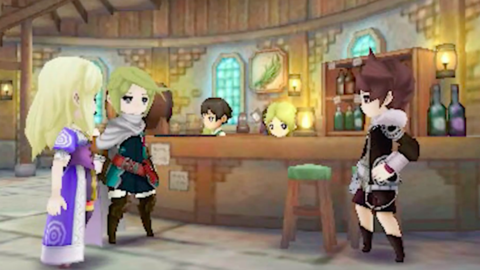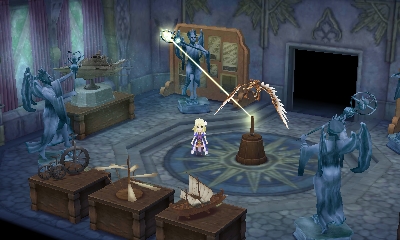The Alliance Alive Review
We’ve Got a Giant Mechanical Duck!
For all the things it does right, The Alliance Alive generally feels like a game that wasn’t quite ready to get pulled out of the oven, but was released anyway. This spiritual successor to The Legend of Legacy features several ideas that sound good on paper, but don’t have the appeal they probably should. This is particularly evident with its too simple yet too complex mish-mash of a battle system, and a narrative that refuses to make the leap from basic plot to grand adventure.
At the game’s outset, all the pieces necessary for an enjoyable RPG with classic sensibilities appear to be in place. Assembling all members of the nine-man party (with another couple of optional allies available to recruit) follows the interesting approach of hopping between three individual storylines, following each unique set of characters until their paths intersect with each other. This kicks off the main story which, unfortunately, becomes much more generic from this point on.
A millennium ago, the Daemon race invaded the human world and took up the mantle of rulers, obscuring the sun with disastrous climate conditions and imposing their laws on their new subjects. The Daemons divided the world into five realms by using the Great Barrier, and made it impossible to travel between them, keeping the humans subjugated and docile. The oppressed populace soon found themselves on the bottom of the food chain. The Beastfolk race was given the task of overseeing Humanity while living alongside them, while the Daemons themselves returned to their own realm.
This is the state of things as the game begins. As often happens when people are systematically kept down, an underground resistance movement has started in the human town of Svalna, sweeping up two young humans, Galil and Azura, in its wake. This is where the first few story threads originate; even when the game swaps locations and protagonists during the first handful of hours, it goes without saying that all concurrent stories eventually overlap as part of the humans’ struggle for freedom.
Unfortunately, it’s about the time the disparate plot threads run together that the narrative begins to flatline. The earlier episodic storytelling that put characters first and forced players to learn about the world through inference and deduction gives way to a far more pedestrian “save the world” plot in which character development takes a back seat. It starts to feel like the story is just a checklist of plot points being dragged along by the constant menagerie of locations, character interactions, and monster encounters. While it isn’t without at least some attempts at interesting character-driven plot points, there’s an unfortunate emphasis on repetitive “destroy five of this” or “gather four of that” missions just to pad out the game, rather than a gripping narrative that justifies the extra hours of gameplay.
The actual gameplay systems suffer from a similar lack of refinement as the story; neither the game’s combat nor its guidance or character progression systems are deal breakers on their own. But when niggling little irritants and frustrations continually rear their ugly heads, it adds up, and the end result is a game that takes a step back every time it seems poised to grow.
One case of this occurs soon after the heroes join forces, as players are granted access to a ship that greatly expands the scope of exploration. The trouble is that there simply aren’t enough interesting things to find, not to mention the swarms of high-level enemies roaming the seas that make instant travel using the ship’s autopilot a much more attractive option. There are a few nebulous objectives that must be accomplished, along with vague directions how to get to them, but it all boils down to the excitement level of “go somewhere and do something.” Many players will find themselves fighting off ennui from fruitlessly stalking around low-level areas with zero challenge before eventually chancing upon the area they were intended to go to.
The Alliance Alive‘s combat system is also full of perplexing design choices. It features a slew of options, though most of them are poorly explained, and the game offers no incentive to learn them until it’s too late. Combat unfolds in rounds, with players inputting all battle commands at the start of a round, then watching good and bad guys take turns having at each other. The system is very grind friendly: combat can be sped up, and there is even an Auto Battle mode that simply repeats all commands used in the previous round until one side or the other succumbs. Damage is healed automatically after every battle, and spent Skill Points (SP) regenerate slowly during battle rounds. Even being knocked out merely reduces a character’s max hit points, letting them readily participate again in the next battle, albeit at reduced health until they can rest at an inn.
Rather than a traditional leveling system, characters may randomly gain a a variety of points after each encounter: HP, SP, or Talent Points, the last used to unlock individual characters’ buffs and status improvements. Learning new combat skills for a particular weapon happens randomly during actual combat, simply by using that weapon. With a party of up to five characters in battle simultaneously, the result is a satisfying ongoing drizzle of stat boosts, and it’s rare that a battle against appropriately-scaled foes doesn’t yield some sort of immediate gratification.
The down side to such a forgiving combat system is that for the vast majority of the game it presents too little challenge to get players to learn its myriad of tacked on features and systems. There are many considerations that go into creating a proper character build: each ability and piece of equipment comes with its own treasure trove of stats, skills must be learned for each of a characters’ two weapons, decisions have to be made as to how to best spend the relatively scarce Talent Points to keep each character properly upgraded, and various battle formations, each with its own pros and cons, must be considered. Or one can simply take the easy approach, brute forcing through battles and letting the combat system’s ins and outs worry about themselves.
For all this versatility, the trouble is that ninety percent of the battles are so laughably easy that there is zero incentive to really dig in and learn it; it’s simply not necessary to have a grasp on formations and talent upgrades until very late in the game, and by then it may already be too late to do much with them if they’ve been neglected or handled poorly. The game does a subpar job of encouraging players to learn these deeper aspects, and when the endgame’s increased difficulty demands their effective use, the whole affair becomes a frustrating roadblock just when the narrative enters its climax — an unfortunate time to slow down and begin the learning process that should have happened much earlier. In this reviewer’s playthrough, all these aspects coalesced during the game’s finale, resulting in a near-impossible situation with a useless save file and no way back. Only after hours upon hours of additional, mind-numbing grinding was the incredible difficulty spike of the final boss overcome, whereas all bosses up to that point were blown through without any trouble. Whether due to poor planning on the developer’s part or shoddy character management on mine, it resulted in one of the most frustrating game experiences I’ve had in recent memory, and not one that will win any points for an already mediocre game.
At least it’s a little harder to knock The Alliance Alive‘s graphical presentation and music compositions. While certainly not groundbreaking, the graphics are colorful and richly detailed. Of particular note are the interesting character designs, with each member of the main cast brimming with visible personality, though the palette swap monster designs don’t impress, and in some cases just feel odd and out of place. Lots of care was taken to pack the indoor living environments with flair. Outdoor areas when traversing the world map are still attractive enough, but a little less impressive. The game offers no option of voiced dialog, and its musical themes are melodic and catchy enough. However, after the first few hours to sample the music on offer, there’s little reason not to turn it down, especially as the game does lend itself to grinding through some areas while catching a TV program. Neither the visuals nor the music do much to distinguish themselves in any meaningful way, but they’re certainly not low points either.
For all the ways The Alliance Alive seems like a pleasant throwback RPG early on, it features too many frustrating design decisions and gameplay systems that have little impact until the endgame. It all adds up to a game experience that elicited very little satisfaction, ending with a variety of negative emotions and an unpleasant lasting taste. Players familiar with this game’s roots, or willing to delve into systems much more complex than the foes they face, may yet find some satisfaction here, though more in its drip-feed character growth than any engaging narrative. Others, however, may have trouble seeing past the boredom and frustration to get much enjoyment out of it.


Character growth is steady and consistently satisfying
Visuals are colorful and feature polished character designs
Dull story featuring aimless wandering
Game isn't interested in teaching you how to master its combat system








Thanks for sharing your thoughts, Pascal. The diversity of views on this game among members of the podcast left me wondering how the review would turn out. Kelley seemed to like it—sorry to see that you did not.
Overall, I found Alliance Alive to be a solid experience. The story was not genre-defining, but it was vastly better than Legend of Legacy and it kept my interest throughout. Combat was consistent with that found in SaGa titles and that worked for me. It may not be to everyone’s taste, but as a big fan of SaGa Frontier and Romancing SaGa, this game brought back some good memories.
The random spikes in difficulty are one area where we are in full agreement. I hit one spike around the game’s mid-point and a second in the final dungeon. The latter was a serious detraction from an otherwise enjoyable gaming experience.
The Alliance Alive suffers its share of problems, but I have no reservations in recommending it to others. From my perspective, it is yet another addition to the the 3DS’ well-established library of excellent JRPGs.
I feel slightly differently, sure it adds to the 3DS in regards it’s JRPG line-up but it’s Mediocre at best.
I love the game but like all things SaGa-ish it never surprises me when others don’t like it. I will say I wish it was a lot harder as many battles have been way too easy. I’ve actually tried to avoid some combat to try and stay a bit on the under-leveled side.
Agreed, Wheels. I have been a fan of the SaGa franchise long enough to accept that it doesn’t resonate with everyone.
Regarding the difficulty, I had the same feeling for 95+% of the game. Most of the combat was ridiculously simple and Pascal’s point that the player is never required to learn the intricacies of combat (until it is too late) is well taken. As I mentioned above—there were two notable difficulty spikes that seem to catch players unprepared. The one in the final dungeon is frustrating if you have not put time into learning the combat during the game’s first 30 hours or so.
For that reason I think Legend of Legacy’s combat will certainly stick with me more, but so far Alliance Alive’s characters and world have certainly been quite fun.
Gamesreq, I think we’re on the same page. Your complaint about the difficulty spike – especially in the final dungeon – probably bothered me more than it did you. I’m not too familiar with the Saga series, so the combat irked me, and I feel like the difficulty spikes could have been mitigated had I been on top of the combat system more, which is something I’d trust a game to teach me.
Much as it saddens me that you didn’t enjoy the game, you are absolutely right that you should expect the game to teach you at least a little bit.
Wheels – if I had to pick one, I would probably go with the combat system in Legend of Legacy as well. It presented a more significant challenge throughout and required a greater degree of strategizing.
Squiggyleo – sorry to hear that your experience with Alliance Alive was comparable to Pascal’s. Like any of the SaGa titles, the combat either works for you or it doesn’t. Your opinion is not a minority one—even among JRPG fans. I think a lot of people went into Alliance Alive expecting something similar to the Bravely games. Outside of character design and the world map, however, there are not a lot of similarities between the two and I can see where that left some people disappointed.
Your point about the game teaching you more about the combat system early on is fair. That said, the early combat is so easy that most people might have blown through any tutorials deeming them unnecessary.
I’m curious. What does the game not teach early on? I’d like to give this a shot and try to learn the tough stuff as I go. Any tips for things to go out of the way to learn so that I don’t hit the road blocks?